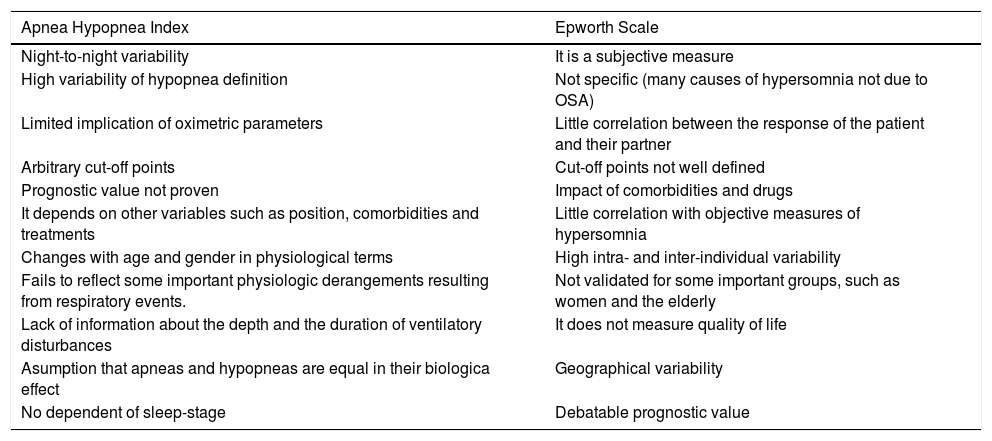More than a billion individuals worldwide suffer from an excess of sleep-disordered breathing, with obstructive sleep apnea (OSA) undoubtedly being the most common form.1 Due to its extraordinarily high prevalence1 and negative health consequences,2-4 OSA is now considered an evident public health problem, especially in those countries where overweight or obesity (the main risk factors for OSA) are also a common conditions.1 In most pulmonology departments (and, of course, sleep Units), OSA is the most frequently assessed disease. The health costs caused by OSA (especially in its severe or untreated forms) are three times that of an individual without OSA, while more than 80% of cases remain undiagnosed.5
Two of the main characteristics of OSA are its complexity (no single variable is capable of capturing its severity or prognosis, and its origin may involve different pathophysiological mechanisms (endotypes), some with possible therapeutic consequences),6-8 and its heterogeneity9,10 (various forms of presentation and clinical phenotypes, which sometimes complicate the suspected diagnosis). Although the guidelines for clinical practice often recommend individualizing cases when establishing a diagnosis and treatment of OSA (according to the presence or absence of a set of variables),11 the truth is that in routine clinical practice only two of these variables are usually used to both make a diagnosis and propose a therapeutic regimen: the apnea-hypopnea index (AHI) per hour of sleep and the value of the Epworth Sleepiness Scale (ESS) as a subjective measure of daytime hypersomnia.12 Various studies have cast doubts, however, on the diagnostic value and severity grading of these two variables in OSA, as well as their relevance for therapeutic decisions and even a prognosis.13,14 Furthermore, the correlation between the two variables is low in most cases.15Table 1 shows some of the limitations of each measure.
Disadvantages of the Apnea Hypopnea Index and the Epworth Scale for the diagnosis, assessment of severity, treatment and prognosis of sleep apnea.
Moving beyond AHI or ESS, however, other variables closely related to OSA have been shown to be of significant value in an assessment of the disease's impact: these include some nocturnal oximetric measures with or without obesity,16,17 some comorbidities and cardiovascular risk factors and the individual's baseline quality of life. For example, recent studies have shown how the hypoxic burden (nocturnal desaturation related to respiratory events during sleep) has a greater prognostic capacity than the AHI for future cardiovascular risk.18 Moreover, measurement of the nocturnal changes in heart rate as a surrogate for the sympathetic activation produced by apneas and hypopneas has also proven to be of prognostic value.19
To date, however, there are no validated multidimensional scores for OSA that groups together a limited number of important easy-to-measure variables on a weighted basis and serves to better approximate the severity or prognosis of OSA and its overall impact on an individual. In our opinion, one interesting approach would be that adopted by some authors for COPD20 or bronchiectasis,21 although this remains to be validated. According to this approach,6 at least three dimensions of OSA should be assessed: 1. Severity (using simple polygraphic variables (software already available), which, in addition to the AHI, would introduce the hypoxic burden, the baseline oxygen measure and at least one nocturnal continuous hypoxia measure as a surrogate for cardiopulmonary diseases or obesity with nocturnal impact on oxygen saturation); 2. Disease activity, which could easily be measured by nocturnal variability in heart rate (as a surrogate for sympathetic activation) or the control of blood pressure levels,22 until the emergence of new well-validated biomarkers (especially cardiovascular, pro-inflammatory and metabolic biomarkers),23,24 and 3; The impact of the disease on the patient (assessed via the ESS, although ideally a simple quality-of-life questionnaire could be developed to include hypersomnia as only one of the dimensions, alongside others with a personal or socially related impact and an assessment of psychological/neurocognitive disorders such as depression). Obviously, this new multidimensional score should be validated (and eventually modified) not only in middle-aged men (as has traditionally, and erroneously, been the case in most studies on OSA) but also in women and the elderly. It should also be validated as a measure of the overall severity of the disease and its prognostic value, especially on the cardiovascular front (together with other important variables in this respect, such as cardiovascular risk factors, including obesity, and previous cardiovascular disease); it should be integrated in the telemedicine management of the patient25-27 (the rapid development of telemedicine is probably one of the few positive things that the sleep community has obtained from the COVID-19 pandemic situation),28 and finally, it should be validated with respect to response to treatment (since all the variables that comprise this score are potentially modifiable with treatment). It is true that some measures of interest, such as sleep fragmentation, analytical biomarker values and the measurement of more complex pathophysiological variables, would not enter this score, but there is a crucial need for maximum simplicity in order to enhance the generalization of its use, given the epidemiological relevance of the disease.
Ultimately, although our proposal may be just one of the many (better or worse) that may appear, what seems certain is that we cannot continue to exclusively link the severity of OSA, and the therapeutic decisions on this disease, to variables that present as many limitations as the AHI and the ESS values. We must be aware that, in the world of progress towards precision medicine and personalized treatment, OSA lags behind other respiratory diseases and that the scientific sleep community should focus its efforts on reversing this situation as soon as possible.
Funding/ Conflicts of interest: The authors have nothing to declare in relation to this manuscript.








